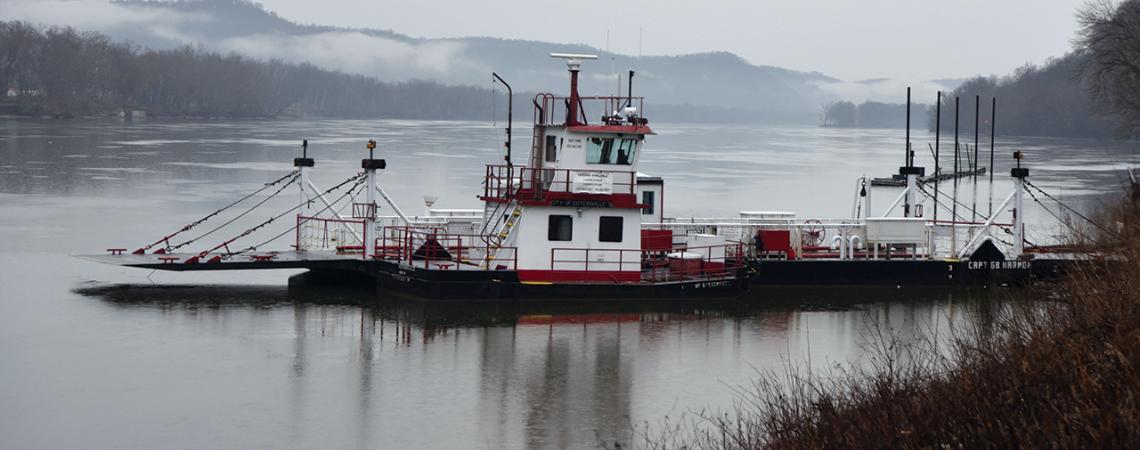The City of Sistersville II patiently awaits early May - the beginning of her season.
Before there were bridges across the mighty, sometimes swift and muddy Ohio River, there were dozens of ferries that carried people, cargo, and the vehicles of the day from Ohio to Kentucky and West Virginia. Today, there are nearly 50 bridges, but only three ferries remain. Each of those that still ply their trade is cherished.
The Anderson Ferry, operating a dozen miles west of Cincinnati, is the busiest. Its three vessels and their crew deliver hundreds of passengers every day but Christmas. While the nearby Northern Kentucky International Airport and area businesses rely on the ferry, lots of folks take it just for fun. “We get plenty of people who just enjoy the ride,” says owner Paul Anderson, who may or may not be related to the George Anderson who founded the ferry in 1870.
The ferries feature towboats, all named for Daniel Boone, that are attached to flat barges on a large pole, swinging around to reverse direction at each riverbank. The original Anderson Ferry had a rope that captains used to propel themselves across the river. That soon evolved into a two-horsepower paddle wheel configuration — literally, that is: Two horses walked on a treadmill to power the paddle wheel.
More recently, one of Anderson’s towboats underwent a one-of-a-kind outfitting. “It’s the only ferry I know of with a Mack truck engine,” Anderson says.
About 60 river miles upstream is another historic ferry, in operation since 1797, when it, too, was hand-propelled. Today, the Augusta Ferry’s modern version still performs the same task between Augusta, Kentucky, and Higginsport, Ohio. For walk-on passengers, the trip is free.
Audrey Clos and Sheryl Cruse, who live nearby, recently enjoyed lunch with their grandchildren and decided to see the sights in the quaint river town.
“It was such a pretty day that after we had pizza, we decided we’d take a little walk down by the river. When we came around the corner, we saw the ferry coming in. So I said, ‘C’mon, kids!'” Cruse says. “The price is a great deal, too,” she adds, laughing.
Captain Devin Claypool says the Jenny Ann runs all year long, river and weather permitting. Sometimes, though, they just don’t permit.
“I got stuck one year in about 2 or 3 inches of ice. Got halfway across and couldn’t go anymore, so I wriggled around a little bit, got turned around, and headed right back the way I came,” he says.
The Augusta Ferry is truly full-service, according to deckhand Jerry Mofferd. “We might get stuck sitting on the other side for a few hours,” he says, “but if we see a car back here, we’ll come get ’em.
“I’ve been doing this a long time,” he continues. “There’s people who — I know who they are and I know their entire family history, and to me, they’re just like family.”
After taking Taylor Royalty’s five bucks, Mofferd chats it up with the Ohio resident, who drives to visit her boyfriend across the river regularly. When asked if Mofferd is bothering her, she laughs. “No, absolutely not,” she says. “He’s my favorite one on the ferry. I enjoy talking every time.”
About 350 river miles upstream, in the middle of what future president George Washington in 1770 called “The Long Reach” — the straightest 20-mile section in the 981-mile river — another historic ferry has in recent years struggled to remain.
The Sistersville Ferry, linking Sistersville, West Virginia, and Fly, Ohio, is a beloved one. Barb Gage, president of the ferry’s board, says times have been tough for the little ferry the last decade or so. It’s owned by the city of Sistersville and is required to be self-supporting.
“What really hurt us is when the price of diesel went way up,” she says, going on to describe a newly required maritime insurance policy as extremely expensive. “We just can’t afford to run seven days.”
“We only run Thursday through Sunday and May through October,” explains Janet Witten Conn, another board member. “If we extended its operation, we wouldn’t be able to run in the black. It’s been here for better than 200 years, so we don’t want that to go away.”
For the small sum of $1 anytime, folks can ride the ferry back and forth across the river as many times as they wish, so long as they don’t disembark.
Gage says captains and deckhands aboard the Sistersville II, like those on the Jenny Ann, have never met a stranger.
“That’s what happens — they get to know everybody and become like family. So much that we just had a request for our retired captain to return for a day, just so he can captain for a high school graduation party on the ferry for a customer’s son, who’s always loved the ferry.”
Each July, the two water-linked communities celebrate their connection with a fundraising event that spans the river. The Ferry Festival has helped keep the Sistersville II afloat, hosting more than 1,200 passengers during the festival.
Nowadays it’s just plain too easy to cross by bridge. Instead, try grabbing a map (or a cellphone) and find the ferries. Get right down on the water, and enjoy the modern version of the old ride. Maybe you’ll make a friend on the deck.
James Proffitt is a freelance writer from Marblehead.









